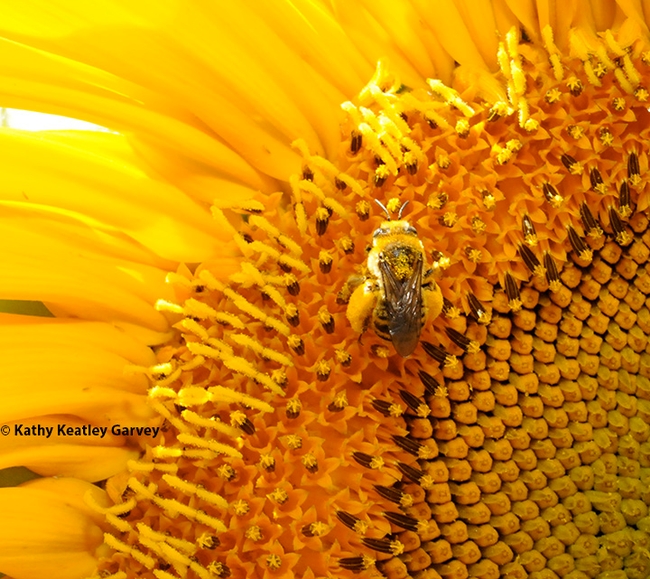Posts Tagged: Bees
Good to See Ettamarie Peterson 'Bee' Honored
It was good to see Sonoma County's "Queen Bee," Ettamarie Peterson of Petaluma, bee honored on the cover of the December edition of Bee Culture magazine. She often submits articles for the magazine. I decided it was time her to...

Ettamarie Peterson, known as the "Queen Bee of Sonoma County," gets ready to greet visitors at the Vacaville Museum Guild's Children's Party, an annual event held every August in the museum courtyard. (Photo by Kathy Keatley Garvey)
Bumble Bee's Red Pollen: 'Tis the Season
Ever noticed that when yellow-faced bumble bees, Bombus vosnesenskii, forage in lupine that their pollen is red? Last July when we were camping at Bodega Bay, we delighted in watching the bumble bees foraging in the lupine. Bumble bees store their...

A yellow-faced bumble bee, Bombus vosnesenskii, packing red pollen from a lupine last July at Bodega Bay. (Photo by Kathy Keatley Garvey)
U.S. Honey Bee Losses Highest Since 2010-11
The American Bee Journal (ABJ) and Bee Culture just released the preliminary results of the annual U.S. Beekeeping Survey and the news is not good. "U.S. beekeepers lost an estimated 55.1 percent of their...

A honey bee today (Dec. 5) forms the centerpiece of a mallow, Anisodontea sp. "Strybing Beauty." (Photo by Kathy Keatley Garvey)

Side view of a honey bee foraging ona winter blossom, Anisodontea sp. "Strybing Beauty." (Photo by Kathy Keatley Garvey)

The honey bee buzzes off to find another blossom in the dead of winter. (Photo by Kathy Keatley Garvey)
Eliza Litsey to Discuss a Novel Queen Honey Bee Treatment
If you're curious about honey bees, queens and juvenile hormones, you'll want to attend or hear the UC Davis Department of Entomology and Nematology (ENT) seminar to be presented by apiculturist Eliza Litsey, a former graduate student in the...

Pointing out the queen bee. Apiculturist Eliza Litsey will present her exit seminar, hosted by the UC Davis Department of Entomology and Nematology, at 4:10 p.m., Monday, Nov. 4 in 122 Briggs Hall. (Photo by Kathy Keatley Garvey)
Outstanding PBS Deep Look Video: 'Why Do Sunflowers Face the Sunrise?'
Sunflowers bring out the best in us. They bring us joy, happiness, hope and unity. But wait until you watch the newly released PBS Deep Look video, "Why Do Sunflowers Face the Sunrise?" that spotlights the research of UC Davis and UC Berkeley...

The newly released PBS Deep Look video "Why Do Sunflowers Face the Sunrise?" is a crowd favorite. (Screen shot)

A bee commonly found on sunflowers is Epimelissodes obliqua expurgata, formerly known as Svastra obliqua expurgata. (Photo by Kathy Keatley Garvey)

